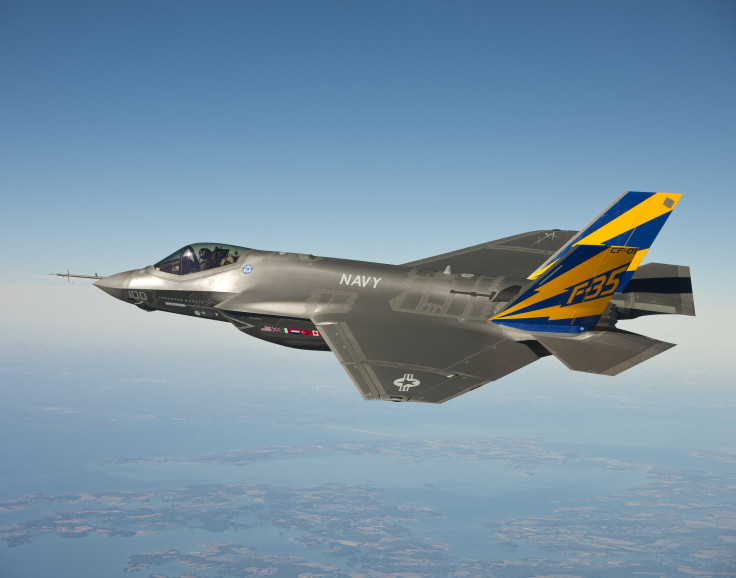Lockheed Martin, In A Dogfight With Boeing, Puts The F-35 On Sale

Lockheed Martin (NYSE:LMT), seeking to give its F-35 a leg up against a rival fighter offered by Boeing (NYSE:BA), is dramatically reducing the F-35 sticker price for the next batch of jets it will sell to the Pentagon.
The aerospace company is offering the base model of the fifth-generation F-35 for $80 million apiece in negotiations with the Pentagon, according to a report from DefenseOne. That's an 11% reduction from the $90 million price last September when the last tranche of the fighters was ordered.
The F-35 has been marred with lengthy development delays and cost overruns, but the plane is now operational and is steadily becoming a key part of the U.S. arsenal. The Pentagon is expected to finalize its next order for the fighter this summer. Analysts have been expecting each batch to come in cheaper than the last, but the amount of this latest reduction is likely to take some by surprise.
New for the price of old
Lockheed Martin has been under constant pressure to bring down the cost of the F-35, but the urgency has increased since the Pentagon reversed course and decided to buy new Boeing F-15s for the first time in two decades. The modernized F-15EX is significantly upgraded compared to the original 1960s-era plane, with a sophisticated electronics suite, but it's still last-generation technology that up until recently was of little interest to military procurement officials.
The decision to buy F-15s, according to the Pentagon's acquisition summary, "reflects the Department's strategy to layer capability to address different threat situations." The government is buying F-35s "to address advance technology aircraft being deployed by Russia and China," the report says. But to defeat lower-technology platforms, it wants to use older designs "which nominally have lower operating costs when compared to 5th generation combat jets" such as the F-35.
Cost is the key. The F-15 decision came down to the Pentagon wanting to squeeze as much military might as possible from limited funding, and at a time when the military has a long wish list for new equipment.
At $80 million per unit, the F-35 is within range of an F-15. Lockheed's sales pitch to the government is that there's no logical reason to buy last-generation technology when you can get cutting edge for about the same price.
More than just the sticker price
While Lockheed Martin has made steady progress bringing down the sticker price, other costs remain in Boeing's favor. The Pentagon is hoping to get the operating cost of an F-35 down to $25,000 per hour by fiscal 2025, down from about $44,000 per hour in fiscal 2018, but defense officials are not sure that target is obtainable.
Robert B. Daigle, director of the Pentagon's Cost Assessment and Program Evaluation office, during a House Armed Services subcommittee meeting in early May said the $25,000 number is "a target and it's not our projection for where we're actually going to be."
The F-15, by comparison, is significantly more affordable to operate with an estimated cost of less than $30,000 per hour. Daigle said that the Pentagon estimates the overall cost of ownership of an F-35 over a 10-year period is $47 million more per aircraft than that of an F-15 operated a similar amount of time.
"These 4th generation fighters are the most cost-effective way to meet lower-end mission demands, which ensures our 5th generation fighters are available for high-end fights," Daigle said in his prepared testimony.
Lockheed Martin for its part is considerably more optimistic that it can hit the $25,000 target, noting that the company has reduced its portion of the cost per flying hour by 15% since 2015. The hope is that as jet production ramps up, so too will production of the widgets and components that go into the jet, reducing the overall cost of spare parts. Maintenance costs should also decrease as the Pentagon gains more experience working on the F-35.
Lockheed is the long-term winner
Lockheed Martin's cost-cutting efforts are unlikely to halt the purchase of F-15s, but they are an important step in the right direction for the company regardless. Lockheed appears to be on track to hit its long-standing goal of lowering the flyaway cost on a base model F-35 to $80 million by 2020, which should help it secure a steady stream of orders in both the U.S. and from allies and keep the F-35 on target to be a trillion-dollar warplane for the company and its key suppliers.
Lockheed Martin is a best buy among defense contractors because of the diversity of its offerings, but even with that broad portfolio, the F-35 remains a critical factor in the company's long-term success. No matter what the Air Force decides to do with the F-15, it seems certain that the Pentagon is going to buy plenty of F-35s well into the foreseeable future.
No matter how this battle goes, Lockheed Martin is winning the war.
This article originally appeared in the Motley Fool.
Lou Whiteman has no position in any of the stocks mentioned. The Motley Fool has no position in any of the stocks mentioned. The Motley Fool has a disclosure policy.




















